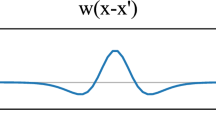Abstract
In this paper, I propose a neurophysiologically plausible account for the evolution of arbitrary, categorical mental relationships. Topographic, or structure-preserving, mappings are widespread within animal brains. If they can be shown to generate behaviours in simulation, it is plausible that they are responsible for them in vivo. One behaviour has puzzled philosophers, psychologists and linguists alike: the categorical nature of language and its arbitrary associations between categories of form and meaning. I show here that arbitrary categorical relationships can arise when a topographic mapping is developed between continuous, but uncorrelated activation spaces. This is shown first by simulation, then identified in humans with synaesthesia. The independence of form and meaning as sensory or conceptual spaces automatically results in a categorial structure being imposed on each, as our brains attempt to link the spaces with topographic maps. This result suggests a neurophysiologically plausible explanation of categorisation in language.
Access this chapter
Tax calculation will be finalised at checkout
Purchases are for personal use only
Preview
Unable to display preview. Download preview PDF.
Similar content being viewed by others
References
Adams, D.L., Horton, J.C.: Ocular dominance columns: Enigmas and challenges. The Neuroscientist 15(1), 62–77 (2009)
Bargary, G., Mitchell, K.J.: Synaesthesia and cortical connectivity. Trends in Neurosciences 31(7), 335–342 (2008)
Bickerton, D.: King of the sea, 1st edn. Random House (1979)
Borovsky, A., Elman, J.: Language input and semantic categories: A relation between cognition and early word learning. Journal of Child Language 33(04), 759–790 (2006)
Carnap, R.: Logical Foundations of Probability. University of Chicago Press, Chicago (1950)
Ellison, T.M.: Induction and inherent similarity. In: Similarity and Categorization, pp. 29–50. Oxford University Press (2001)
Goodhill, G.J.: Topography and ocular dominance: a model exploring positive correlations. Biological Cybernetics 69(2), 109–118 (1993); PMID: 8373882
Goodhill, G.J., Sejnowski, T.J.: A unifying objective function for topographic mappings. Neural Computation 9(6), 1291–1303 (1997)
Greenlee, M.W.: Human cortical areas underlying the perception of optic flow: brain imaging studies. International Review of Neurobiology 44, 269–292 (2000)
Harrison, J.E., Baron-Cohen, S.: Synaesthesia: Classic and Contemporary Readings. Wiley-Blackwell (January 1997)
Hlutk, P., Solodkin, A., Gullapalli, R.P., Noll, D.C., Small, S.L.: Somatotopy in human primary motor and somatosensory hand representations revisited. Cerebral Cortex 11(4), 312–321 (2001)
Hubel, D.H., Wiesel, T.N.: Receptive fields, binocular interaction and functional architecture in the cat’s visual cortex. The Journal of Physiology 160(1), 106–154 (1962) PMID: 14449617 PMCID: 1359523
Hubel, D.H., Wiesel, T.N.: Receptive fields and functional architecture of monkey striate cortex. The Journal of Physiology 195(1), 215–243 (1968)
Ide, C., Fraser, S., Meyer, R.: Eye dominance columns from an isogenic double-nasal frog eye. Science 221(4607), 293–295 (1983)
Langers, D.R.M., Backes, W.H., van Dijk, P.: Spectrotemporal features of the auditory cortex: the activation in response to dynamic ripples. NeuroImage 20(1), 265–275 (2003) PMID: 14527587
Le Vay, S., Wiesel, T.N., Hubel, D.H.: The development of ocular dominance columns in normal and visually deprived monkeys. The Journal of Comparative Neurology 191(1), 1–51 (1980)
Majid, A., Boster, J.S., Bowerman, M.: The cross-linguistic categorization of everyday events: A study of cutting and breaking. Cognition 109(2), 235–250 (2008)
Majid, A., Gullberg, M., van Staden, M., Bowerman, M.: How similar are semantic categories in closely related languages? a comparison of cutting and breaking in four germanic languages. Cognitive Linguistics 18(2), 179–194 (2007)
Peirce, C.S., Hartshorne, C., Weiss, P., Burks, A.W.: Collected Papers of Charles Sanders Peirce. Harvard University Press (1931, 1958), http://books.google.com/books?id=G7IzSoUFx1YC
Penfield, W., Boldrey, E.: Somatic motor and sensory representation in the cerebral cortex of man as studied by electrical stimulation. Brain 60(4), 389–443 (1937)
Penfield, W., Rasmussen, T.: The Cerebral Cortex of Man. Macmillian (1950)
Pettigrew, J.D.: Bi-sensory, striped representations: comparative insights from owl and platypus. Journal of Physiology-Paris 98(1-3), 113–124 (2004)
Ramachandran, V., Hubbard, E.: Synaesthesia – a window into perception, thought and language. Journal of Consciousness Studies 8(12), 3–34 (2001)
Rissanen, J.: Modeling by shortest data description. Automatica 14, 465–471 (1978)
Schluppeck, D., Glimcher, P., Heeger, D.J.: Topographic organization for delayed saccades in human posterior parietal cortex. Journal of Neurophysiology 94(2), 1372–1384 (2005) PMID: 15817644
Schott, G.D.: Penfield’s homunculus: a note on cerebral cartography. Journal of Neurology, Neurosurgery, and Psychiatry 56(4), 329–333 (1993) PMID: 8482950 PMCID: 1014945
Shillcock, R., Kirby, S., McDonald, S., Brew, C.: Filled pauses and their status in the mental lexicon (2001)
Silver, M.A., Kastner, S.: Topographic maps in human frontal and parietal cortex. Trends in Cognitive Sciences 13(11), 488–495 (2009)
Solomonoff, R.J.: A formal theory of inductive inference. Information and Control, 1–22, 224–254 (1964)
Swisher, J.D., Halko, M.A., Merabet, L.B., McMains, S.A., Somers, D.C.: Visual topography of human intraparietal sulcus. The Journal of Neuroscience 27(20), 5326–5337 (2007)
Tamariz, M.: Exploring systematicity between phonological and context-cooccurrence representations of the mental lexicon. The Mental Lexicon 3, 259–278 (2008)
Thivierge, J., Marcus, G.F.: The topographic brain: from neural connectivity to cognition. Trends in Neurosciences 30(6), 251–259 (2007)
Thom, R.: Structural stability and morphogenesis. Addison Wesley Publishing Company (1989)
de Thornley Head, P.: Synaesthesia: Pitch-Colour isomorphism in RGB-Space? Cortex 42(2), 164–174 (2006)
Wallace, C.S., Boulton, D.M.: An information measure for classification. Computer Journal 11(2), 195–209 (1968)
Author information
Authors and Affiliations
Editor information
Editors and Affiliations
Rights and permissions
Copyright information
© 2013 Springer-Verlag Berlin Heidelberg
About this chapter
Cite this chapter
Ellison, T.M. (2013). Categorisation as Topographic Mapping between Uncorrelated Spaces. In: Dowe, D.L. (eds) Algorithmic Probability and Friends. Bayesian Prediction and Artificial Intelligence. Lecture Notes in Computer Science, vol 7070. Springer, Berlin, Heidelberg. https://doi.org/10.1007/978-3-642-44958-1_10
Download citation
DOI: https://doi.org/10.1007/978-3-642-44958-1_10
Publisher Name: Springer, Berlin, Heidelberg
Print ISBN: 978-3-642-44957-4
Online ISBN: 978-3-642-44958-1
eBook Packages: Computer ScienceComputer Science (R0)




